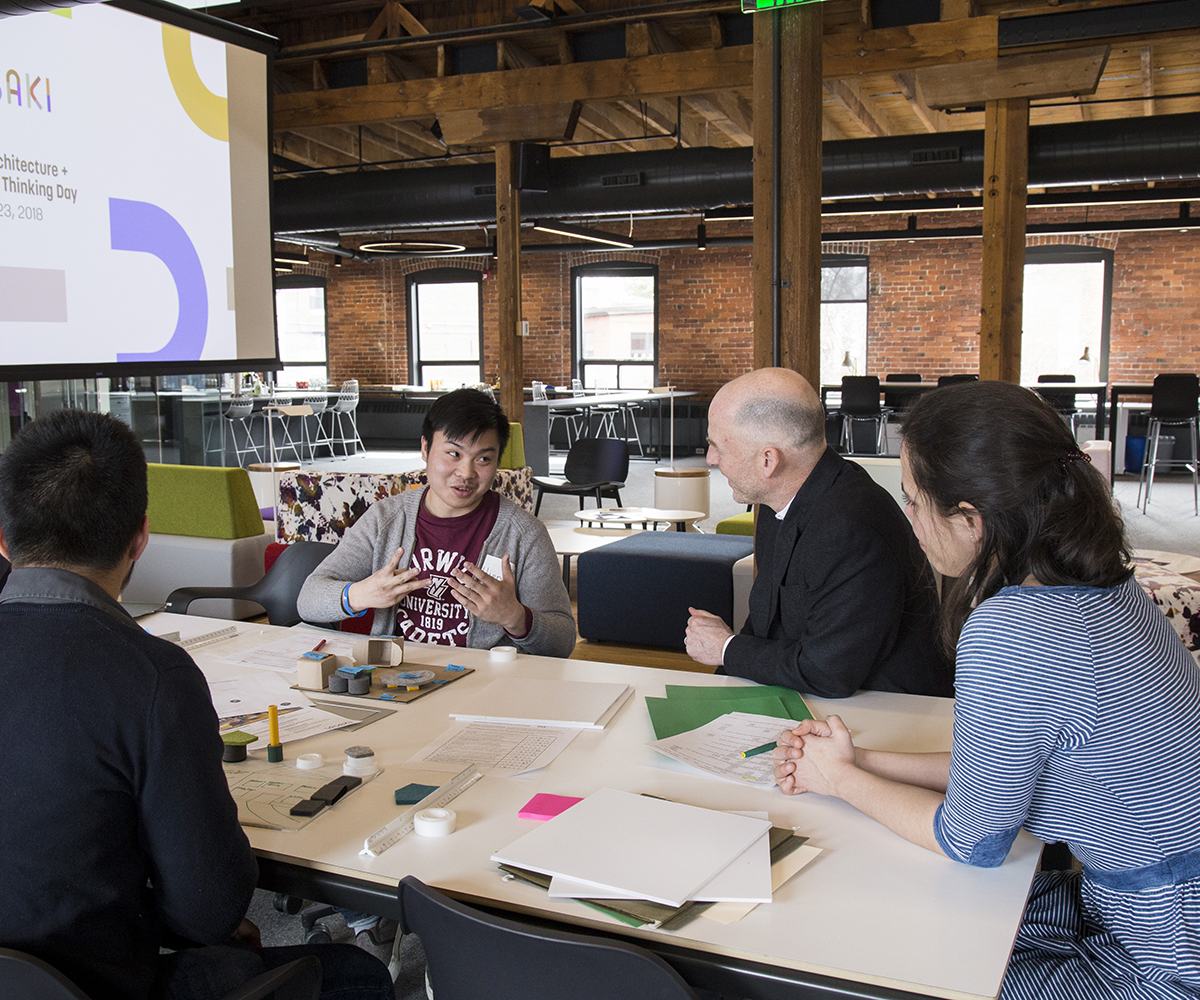June 7, 2018
Harnessing the Power of Design
The following discussion with the Sasaki Foundation’s board chair, Mary Anne Ocampo, and executive director, Alexandra Lee, was moderated by Philip Barash. Barash has served as creative director of Sasaki, leading its place branding practice. He is currently on loan to The Boston Foundation as its inaugural Design Culture Fellow.
It is now a cliché that work no longer looks like work. The past two decades of technological acceleration and shifting cultural priorities have not only changed the way we work, but what constitutes work in the first place. This shift has caused the design profession to grapple with key questions of what we do, how we do it, and why we do it. Designers are increasingly challenged with having to reconcile the craft of design with its mission; with how to be change-makers while being placemakers.
It is in this context that I spoke with Mary Anne Ocampo [third from left], a principal designer at Sasaki, educator at MIT, and board chair for the Sasaki Foundation; and Alexandra Lee [far right], the foundation’s inaugural executive director.
As the Sasaki Foundation is entering a phase of intense growth, learning, and experimentation, our conversation explored the expanding and often uncertain boundaries that define professional practice and social change. If, as the foundation maintains, design belongs to everyone, what implications are placed on public participation and the status of disciplinary expertise? Which voices, opinions, and insights make it into design decisions—and which remain excluded? And how can we, as designers—through creating new kinds of spaces for thinking and making—contribute to lasting outcomes in our communities?
Our discussion took place at the new Incubator at Sasaki, itself a model and catalyst for more inclusive design practices. It was heartening, as the three of us spoke, to see all around us a new kind of professional practice taking shape—and a hint of things to come.
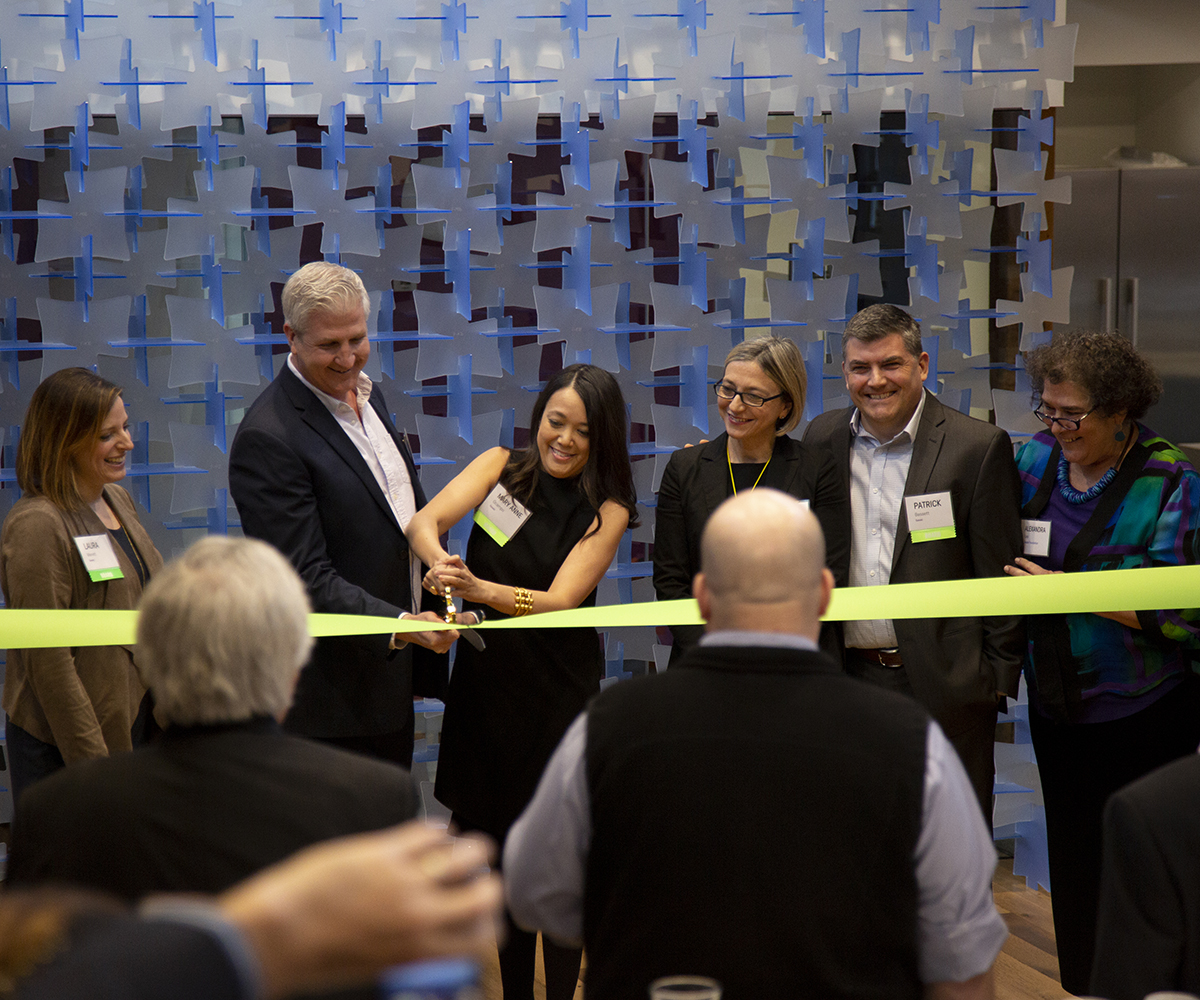
Harnessing the Power of Design
A Q&A with Alexandra Lee and Mary Anne Ocampo
Philip Barash: Let’s dive right into the Sasaki Foundation. Its current provocation is that “the power of design belongs to all of us.” Can you unpack that?
Mary Anne Ocampo: Certainly! It’s an aspirational statement—the power of design should belong to all of us. Is that the case today? Not quite, and that’s what makes the work we’re undertaking so critical. The foundation wants to create a more inclusive design culture, and we believe that begins with listening to and understanding what communities’ needs are. Once that baseline understanding is established, we want to build an infrastructure for involving more and more voices in the process of design.
PB: Could you explain what you mean by “design” in this context?
Alexandra Lee: For now, we’re focusing on areas where design has high impact—the human- and neighborhood-scale of the built environment. What does it feel like to experience the spaces where you live, work, and play? Do you feel safe? Happy? Healthy? Do you feel like you can have a direct impact on the spatial quality of your environments, so that your needs are better met?
PB: Have we failed in some way as designers in previous generations to extract ideas from users or to solicit their participation? Why, in other words, is there a need for this new process that the foundation is creating?
MAO: No, I don’t think that “fail” is quite the right word. In the design industry, most work is client-driven, which sometimes limits the connections between people most in need of more intentional spaces and the designers who can help shape that vision. A critical aspect here is who we are not hearing from and what we’re not hearing. How can we help the populations made most vulnerable by socio-economic inequalities or climate change? How can we amplify their voices?
“A critical aspect here is who we are not hearing from and what we’re not hearing. How can we help the populations made most vulnerable by socio-economic inequalities or climate change? How can we amplify their voices?”
PB: This is almost verbatim to the discussions that we’re having at The Boston Foundation. Our working theory is that the quality of design is improved by the number of opinions, of inputs in the process. More doesn’t always mean better, but in this case, more inputs contribute to more challenging, more vigorous debates. And, ultimately, to design excellence. Does that resonate?
AL: I think that’s right. When you diversify the voices in the room and the perspectives, it enables us as designers or leaders to rethink a challenge from another perspective. And when you invite someone into a conversation, they feel valued from the start and they feel like their ideas are going to matter, and maybe have a positive impact on the world.
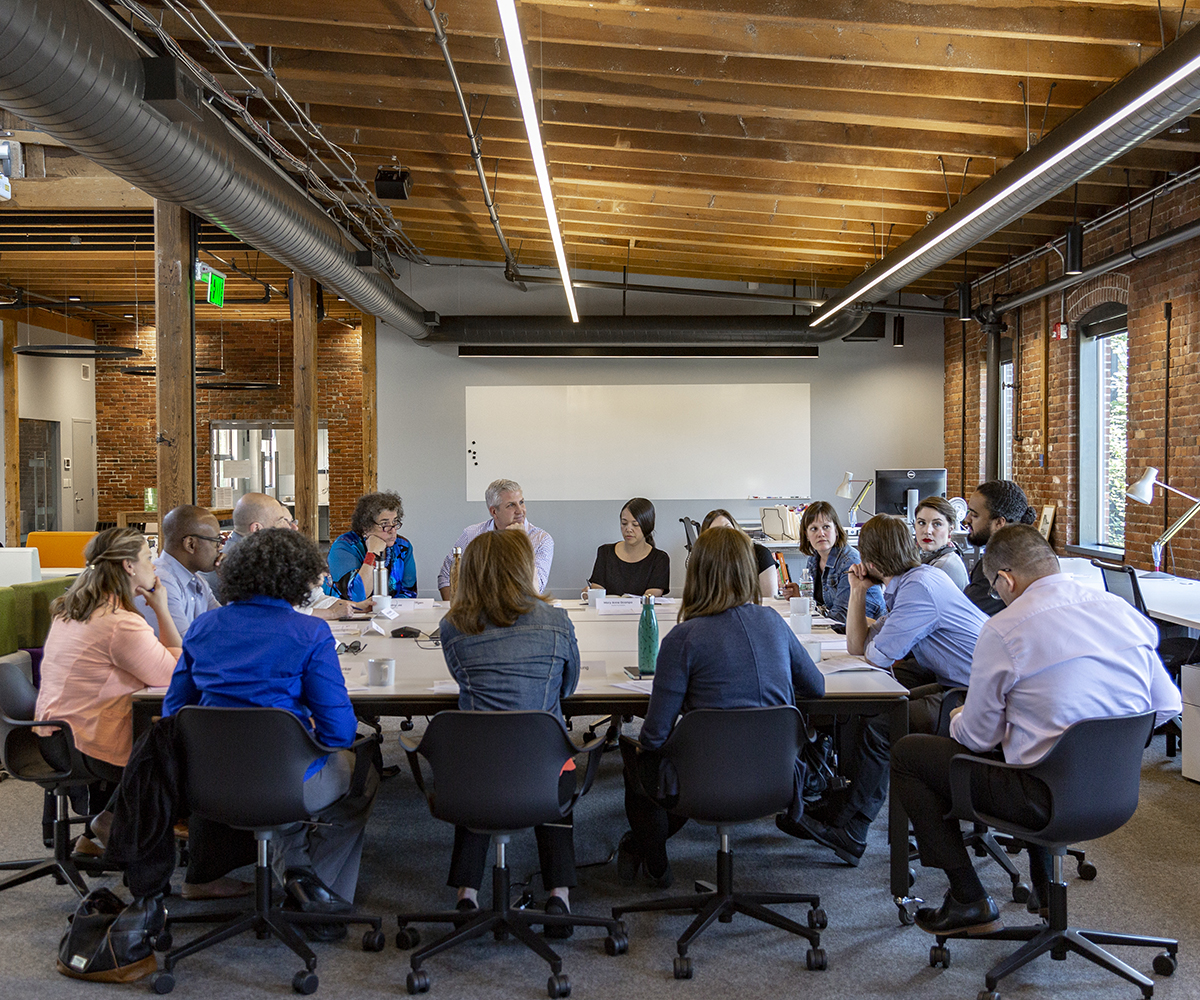
[photo] The Sasaki Foundation’s Board and Advisory Council refine the foundation’s strategic initiatives for the year to come.
MAO: That’s extremely important to our philosophy as a foundation. Our board is a majority women. Our advisory council constitutes a balance of voices, with strong gender, racial, and ethnic diversity. The dynamic of how we interact is so different because of who we are.
PB: My apologies—this is such a classic foundation interview question! How will you put yourself out of business? What vision of the world is the foundation trying to achieve such that the foundation will no longer be necessary?
AL: We’re really in the early stages of our process, but we’re striving to bring vibrancy to neighborhoods in Greater Boston as well as Massachusetts’ Gateway Cities. A perfect example of the transformational change we want to be involved in is the Beyond Walls effort in Lynn, MA, where local and international artists have contributed to creating artistic murals on blighted facades. There’s a lot of pride in forming and shaping the identity of their own community through this celebration of the arts.
PB: That’s a remarkable example, because now Beyond Walls is also managing public space. They’re managing the waterfront public space asset, which started as community-based art. It’s become something else, beyond art-making. It’s become about economic development.
AL: Yes, and it addresses issues around gentrification. More and more communities have begun to find voices to express a sentiment that’s always been there: “this is our space, we don’t want to have it taken over by someone else.” It’s pride. It’s ownership. It’s identity. That pride is very important—we don’t want to be prescribing where we think change needs to happen. We need to work with towns and communities that actually want to make a change themselves.
[photo] The Foundation was a lead sponsor for “Black in Design: Designing Resistance, Building Coalitions,” a Harvard-organized conference promoting the agency of the design professions to address issues of equity and social justice.
PB: It sounds like you’re incorporating a lot more voices, more opinions, more perspectives into this work. Where is design in all of this? Does design act as a facilitator? Common ground? Provocateur?
AL: The design is the glue. How do you take an idea or a vision and craft that into something that’s tangible? With design. It’s what pulls ideas out of our brains to create something that can actually be explained and drawn, and then maybe funded and built. How do you prioritize the important ideas and make them useful, allow them to have impact in people’s lives? Design, and designers, play a really strong role in translating those visionary ideas into reality.
“The design is the glue. How do you take an idea or a vision and craft that into something that’s tangible?… Design, and designers, play a really strong role in translating those visionary ideas into reality.”
PB: Let’s linger there for a second, on the idea of focusing on people. I think that it’s really important to the mission of the foundation, but also it’s such a paradigm shift, a turn in the entirety of design in the past 10 years when we talk about empathy and user-centric design. What were we doing beforehand?
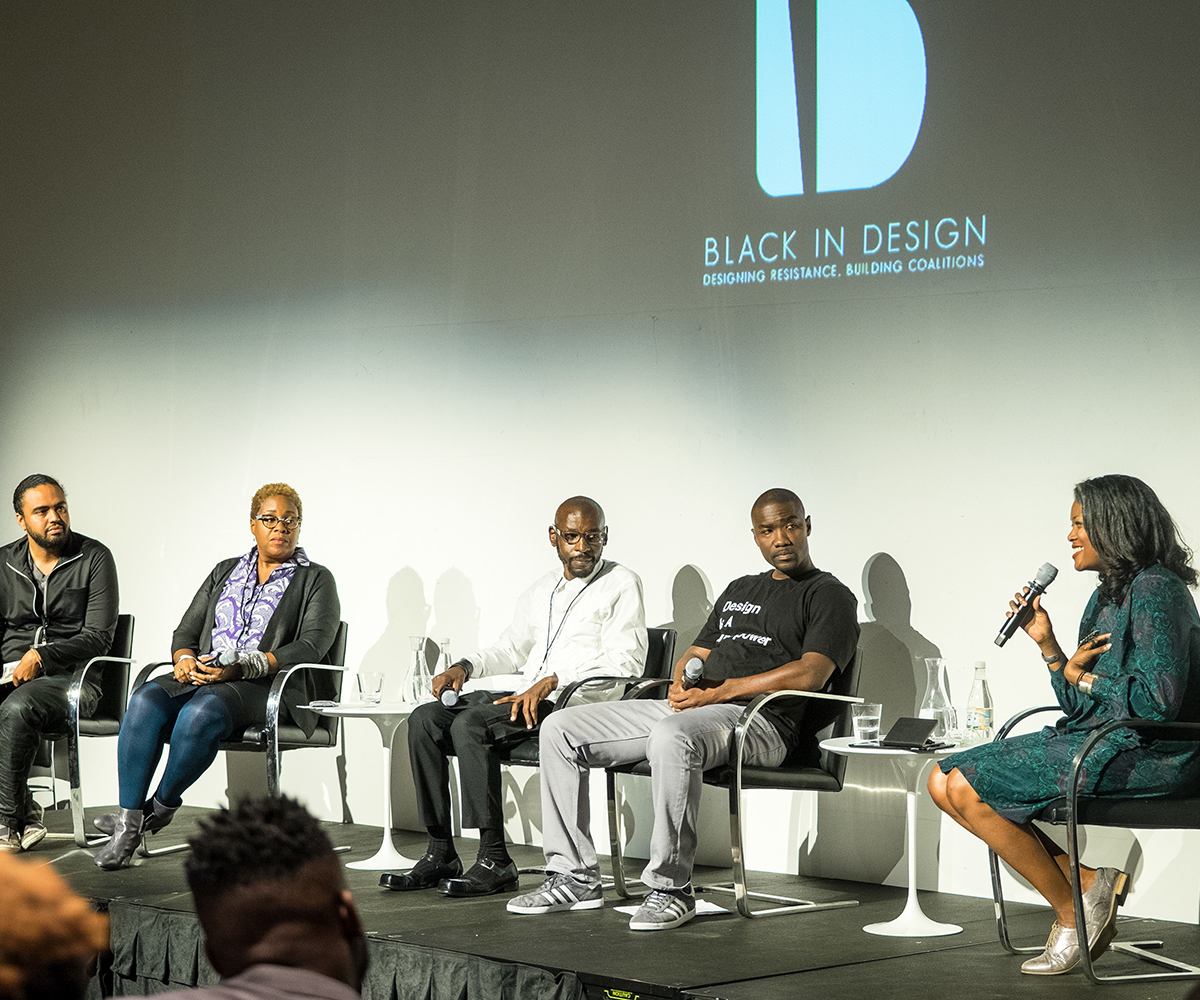
MAO: Design inherently impacts the quality of human life. In the past, some designers prioritized economic efficiency or political expediency, but we believe the driving force for designers should be people. You know, as a lecturer in urban design at MIT, a big part of our conversations are centered on planning and designing for people through the study of the built environment. I think the Foundation’s mission, and this next generation’s, will be advocating for design that is equitable and inclusive.
“… the Foundation’s mission, and this next generation’s, will be advocating for design that is equitable and inclusive.”
AL: The foundation will underscore the importance of the human aspect through how we invite researchers into our grant program. We’re requesting that there be a community advisor on each team, to ground their research in the community they’re studying or working in.
PB: So let’s talk about specifics. How is the foundation going to make change? You mentioned grants there—can you speak more about that?
AL: This is our pilot year and it’s important to note that we’re going to try some things this year and they may shift dramatically, or not dramatically, in the next year. We’re going to be experimental, nimble, responsive to what we see around us. We’ll be putting out a call for proposals this month to solicit ideas for small teams that are addressing certain projects, or looking at prototypes they want to advance, or doing a certain kind of research in a community. We’ll provide a framework that focuses on integrating design and equity in four main topic areas: proactive approaches to climate adaptation, new models for housing, innovation in mobility and access, and creative placemaking/placekeeping. We would like to see applicants’ ideas fall within these four areas of inquiry.
PB: So you’re trying to affect big change in the way that designers practice, in the way that communities—
AL: In the way that communities realize their visions. We want town planners, residents, non-profit groups, technologists, and artists to work together on a community issue—any combination of intelligent and invested doers and thinkers. We’re hoping that the combination of those groups that come in, the people who are tenants in the Incubator, as well as the professionals at the firm will create a beehive-like buzz of ideation—that this place becomes a setting for the exchange of ideas and advancement of each other’s thinking about the particular issue that we’re working on.
“We want town planners, residents, non-profit groups, technologists, and artists to work together… any combination of intelligent and invested doers and thinkers.”
PB: We keep referring to “here” and this mysterious “incubator,” but I think our audience is going to be puzzled. Could you give a quick synopsis of what we’re looking at?
MAO: Well, the Incubator at Sasaki is 5,000 square feet of newly renovated space in an old mill factory, adjacent to Sasaki’s headquarters on their Watertown campus. We spent the last six months renovating this wing of the building to accommodate dynamic, flexible workspaces. This fall, the Sasaki Foundation will be awarding grants to the teams Alexandra was just mentioning. They’ll include a stipend as well as part-time residency here in the Incubator. They’ll share their research along the way through check-ins where they can have dialogues among their cohort grant awardees as well as the public.
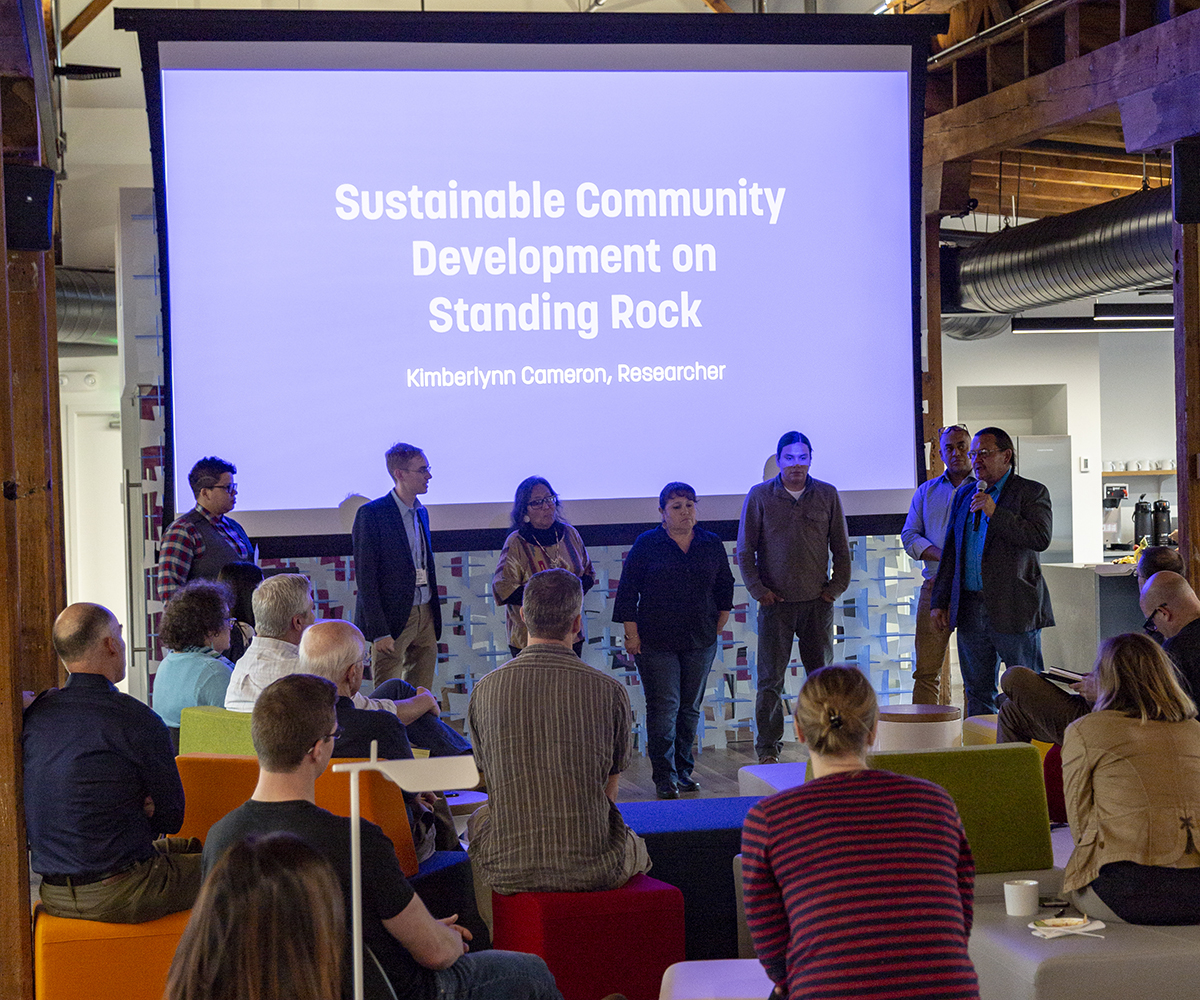
[photo] A recent event, organized by MIT Solve, brought a number of socially-minded entrepreneurs to the Incubator at Sasaki, including several Solve Fellows committed to sustainable and equitable development on the United States’ Native American Reservations.
AL: We are also bringing tenants to the Incubator, utilizing it as a co-working space. We’re imagining a good tenant mix: entrepreneurs working on a product; research fellows working on a project from academia; a technologist working on civic and data visualization, and so on. Beyond that, the Incubator has a strong programmatic element. Recently, we held an event with MIT Solve, in which several of their fellows shared their research—one is pioneering approaches to urban farming in Nigeria, another is providing insect-based protein-rich options in Guatemalan food deserts.
PB: For someone interested in social change, having access to the incredible resources that Sasaki provides—the designers, planners, industry experts, all these talented people—is an amazing resource in itself. How are you facilitating those connections?
AL: The foundation is in an extraordinary position to curate this space, and serve as a relationship broker. Imagine a team comes in and they’ve got an issue that they want to work on, it has to do with the river that’s running through their community and it’s causing a series of challenges they are aware of, but don’t fully understand. Well, Sasaki has ecologists and a hydrologist, and will give that team the opportunity to have one-on-one talks with those experts. So the foundation brokers those meetings and conversations, and the firm will provide consultations with discipline experts. It’s not meant to be pro bono design. It’s catalytic, to get the ideas flowing and projects started.
[photo] Sasaki principal and architect Chris Sgarzi [second from right] and urban planner Rosa Herrero [far right] participate in a recent Boston Society of Architect’s (BSA) Architecture & Design Day, which introduced the design industry to local high school students.
PB: It feels like now is the time; it feels like there’s energy, there’s buzz. Organizations that have just sprung up in the last couple of years are doing really interesting work. The Hideo Sasaki foundation, for instance, has existed for eighteen years, but only last year invested in an inaugural executive director and is rethinking its structure and strategy. Why is this the moment?
MAO: I think that nationally we are seeing everyone become more aware of the major decisions that are being made in regards to the environment, people’s health and wellbeing, and so on. And it’s rippling through all of our communities, all of our cities, everywhere. Particularly with young designers coming along who want to make a difference. We’re seeing a lot of anxiety, but also a renewed energy—that people want to make a difference and they want to participate.
AL: And they’ll take more steps than they have in the past.
MAO: And embrace larger risks. Specific to the foundation, we supported a lot of initiatives in the first 17 years of our operations—sponsoring one-off events, academic research grants, and so on, but it didn’t add up to a cohesive plan for action. Seeing how many people want to be involved in changing their communities and making a difference, with the firm’s backing, we had enough momentum to start a reset on what our aspirations are.
PB: That’s exactly the kind of changemaker and leader that’s really missing from the conversation here.
